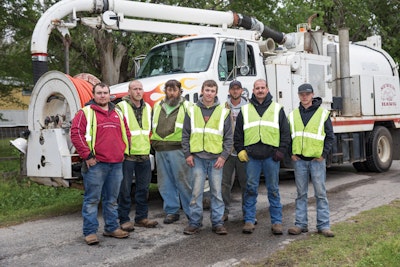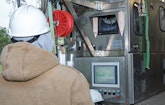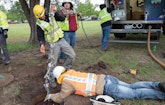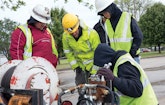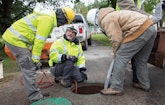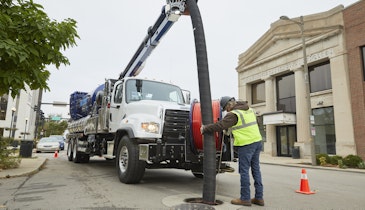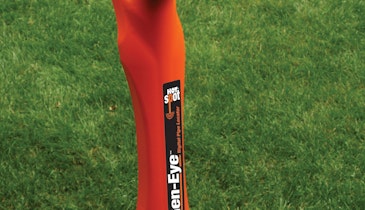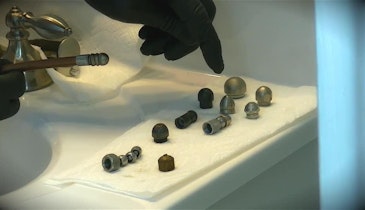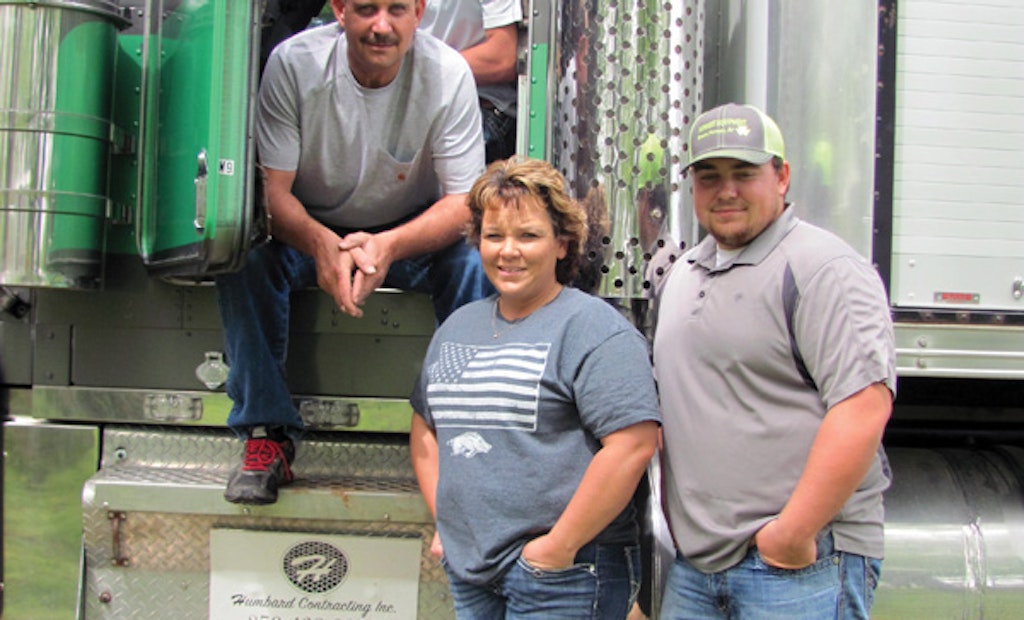
Interested in Municipal/Industrial?
Get Municipal/Industrial articles, news and videos right in your inbox! Sign up now.
Municipal/Industrial + Get AlertsChildren often take inspiration for their career paths from their parents. In the Humbard family, it was just the opposite.
Inspired by their son, Quinton Humbard, and the knowledge base he brought to the business as a recent civil engineering graduate from the University of Arkansas at Fayetteville, Chris and Tammy Humbard restructured their Arkansas excavation firm and took a new direction.
The Humbards moved aggressively into sewer inspection, cleaning and rehabilitation. They parked their bulldozer, excavator and dump truck on their 5-acre facility in Green Forest, Arkansas, and walked away from the buckets and blades in favor of trenchless technology.
Humbard Contracting first hooked up with Illinois-based TT Technologies to learn the basics of pipe bursting. From there the company added a Vac-Con with a hydroexcavation package, and a fully equipped R.S. Technical Services CCTV van. The company took another step in 2015 with lining equipment and training from LMK Technologies.
New direction
Quinton Humbard immediately stepped into a major role as an estimator, field worker, CCTV operator and project coordinator. Tammy Humbard is the other CCTV operator. Quinton’s younger brother Garrett, while still in high school, works with the team as time permits.
Quinton pays close attention to bid notices in local newspapers, various bidding sites such as Bid Ocean Inc., and opportunities with engineering and contracting firms. He visits the project site before putting in a bid, looking for red flags or obstacles that could stand in the way of a professional job.
“We need to know what we are dealing with,” he says. “The line could be in the backyard of a neighborhood, and you have to see where the entrance is, and know what is accessible.
“If we really want a job, we usually come out winning the bid. We usually do not turn down an opportunity to bid. We advertise our capabilities through various channels, including associates we have from the years we did excavation.”
Crews can be on a job as long as six months, depending on the needs of the customer. They will clean, televise, repair and replace laterals and mainlines primarily with trenchless technology. They occasionally dig and replace, but they are seeing a growing demand for trenchless technologies in most municipalities.
Tammy Humbard says that although she and her husband come from an excavating background, they realize times are changing. There are pockets in the country where the dig-and-replace mentality is still prevalent, but new technology is taking hold. By getting on the leading edge, they hope to position the company with the experience and expertise to drive the trenchless market closer to their home base.
Training day
Building a staff of qualified technicians who can help further the company along its new path is no easy task, notes Tammy Humbard.
“We are dealing with specialty equipment, some we own and some we rent,” she says. “We want someone who is going to embrace this technology — someone who takes pride in what the job entails, and understands the importance of doing it correctly. We explain what we do and we look for the same enthusiasm that we feel, not just someone looking for a paycheck. We want someone who wants to be there and do the job correctly.”
She says they devote time to teaching the technology at their facility and on the job site. The process has worked well for lateral lining as well as all other duties.
“On the job site we do hands-on training again to let the technicians build awareness of what they are actually going to be doing. Things don’t always go as easily or as fast as anticipated, but we make sure everybody knows where they need to be and what they need to know.”
During the work cycle on out-of-state projects, they have a per diem package for employees, who can typically travel home on weekends while the equipment stays on site.
Quinton will schedule himself to lead one job, while Chris and Tammy team up on a second project. As president of the company, Tammy is a hands-on administrator who understands the equipment and the job. Jobs are scheduled to make efficient use of equipment. When inspection work is done on one project, for example, the CCTV equipment might move on to the next job, while the jetter stays on location.
“On a recent project in Indiana, we were in a neighborhood where they had a lot of issues with I&I,” Tammy says. “We were there as a subcontractor to install the T-liners into the laterals. We are bidding on another project in the same city for laterals and mainlines.
“The municipalities are beginning to see positive results. They see we fixed one neighborhood and they want us to take a look at another.”
She also notes that many of the smaller municipalities don’t have the equipment to handle this type of work, and would otherwise likely rely on opencut repair or replacement.
The company is often called in to provide CCTV inspection and determine the cause and location of problems.
“An example, a wastewater treatment plant might have an extensive amount of sewage coming to their plant,” she says. “They keep track of the water distributed throughout the city, and they should know based on how much water they are distributing how much should be coming back for treatment. If what is coming back to them to be treated far exceeds what they are distributing, then they know they have a problem.
“When we inspect the pipeline, we find out. There might be a crack in the mainline so there is stormwater when it rains. Not only do you have sewage water, you have rainwater running down the line. We come in to find out what is going on.”
Tammy says the conditions of job sites across the states they work in are similar in many ways. In the older communities it is often clay tile pipe. Most newer towns or neighborhoods have PVC pipe, but even there roots can flourish if there is a crack or the pipe wasn’t installed properly.
“When relining, you go in and cover the possibility of anything getting in that line.”
The next step
Humbard uses LMK equipment for laterals and lines from 4 to 12 inches in diameter. Recently, the company took another step and moved into UV lining for larger mainlines. Humbard consulted with SAERTEX-multiCom to learn about the process. The Humbard crew was able to learn the process and how to use the equipment, and was able to rent the necessary equipment with rental fees applied to the purchase price. SAERTEX will send out a UV truck and operator for Humbard’s initial projects.
“They will become a supplier for our company for future mainline projects.”
Humbard’s relationship with TT Technologies continues. The company’s Grundotugger lateral pipe bursting system includes the bursting unit, bursting heads for 4- and 6-inch pipe, hydraulic power pack and pipe fusion equipment.
Inspections are handled with a full complement of R.S. Technical Services equipment, including OmniEYE cameras and transporters, coupled with IT Pipes software.
On the job
One of the company’s recent sewer repair and rehabilitation projects took the crew to Blackwell, Oklahoma, for a 60-day stay.
This project consisted of replacing approximately 725 feet of 8-inch vitrified clay sanitary sewer with pipe bursting, pulling in new 8-inch HDPE. They also inspected and lined approximately 8,400 feet of sewer line. Another manhole rehabilitation portion of the project was subcontracted.
“We do not offer complete manhole repair at this time,” Quinton says. “We do have a confined-space entry training program and offer that as one of our services.”
The project required re-establishing all lateral connections and maintaining sanitary flow throughout the project. Quinton Humbard served as project manager and ran the CCTV van.
Another interesting project took place in August 2016 when the company was subcontracted to handle lateral cleaning and CIPP lining in Dunkirk, Indiana.
“This was our first project pertaining to CIPP lateral lining,” Quinton says. “The job consisted of approximately 45 lateral CIPP liners to be installed. Dunkirk has opened up bids for another upcoming project that involves lateral lining, and we are planning on submitting bids for that job as well.”
Regardless of where the next job takes the company, Humbard Contracting is establishing a new niche with new technology.
“We believe this is exciting technology and the industry is important for the welfare of our country,” Tammy says. “We like to impart that. Anybody can dig a hole. The true excitement comes when you are not having to tear up a yard to achieve an important goal.”
The proper cure
Humbard Contracting has supported its shift in direction with a relentless determination to find the best processes and provide the most beneficial services for its clients.
From its initial relationship with TT Technologies, its ongoing partnership with LMK Technologies, to the most recent connection with SAERTEX-multiCom, the company has exhaustively worked to bring their company into the trenchless spotlight.
When the company was ready to expand into larger mainline rehabilitation, the Humbards talked to local engineers about their needs and concerns. They wanted a system with a proven track record that meshed well with municipalities’ needs.
Research pointed them toward the UV curing process, and then they were given the opportunity to observe a demonstration for an Arkansas engineering firm, where they saw firsthand the benefits of a UV-cured mainline CIPP project.
“There were no folds or wrinkles in the curing process,” says Tammy Humbard. “Also, with UV lining the process does not allow for any styrene to escape into the environment, making it a logical solution for environmentally sensitive areas. With the SAERTEX UV product we can line anywhere from 6- to 64-inch pipe with several different liner products in many different situations.”
Humbard says she was personally impressed with the company and the passion they showed for their product.
“As a contractor trying to push the new technology in our area it was very helpful to have a company willing to provide the demonstration of the product, and then answer any questions we had. We feel confident in their product because they are confident in their product.
“They are all about the contractor being successful.”
